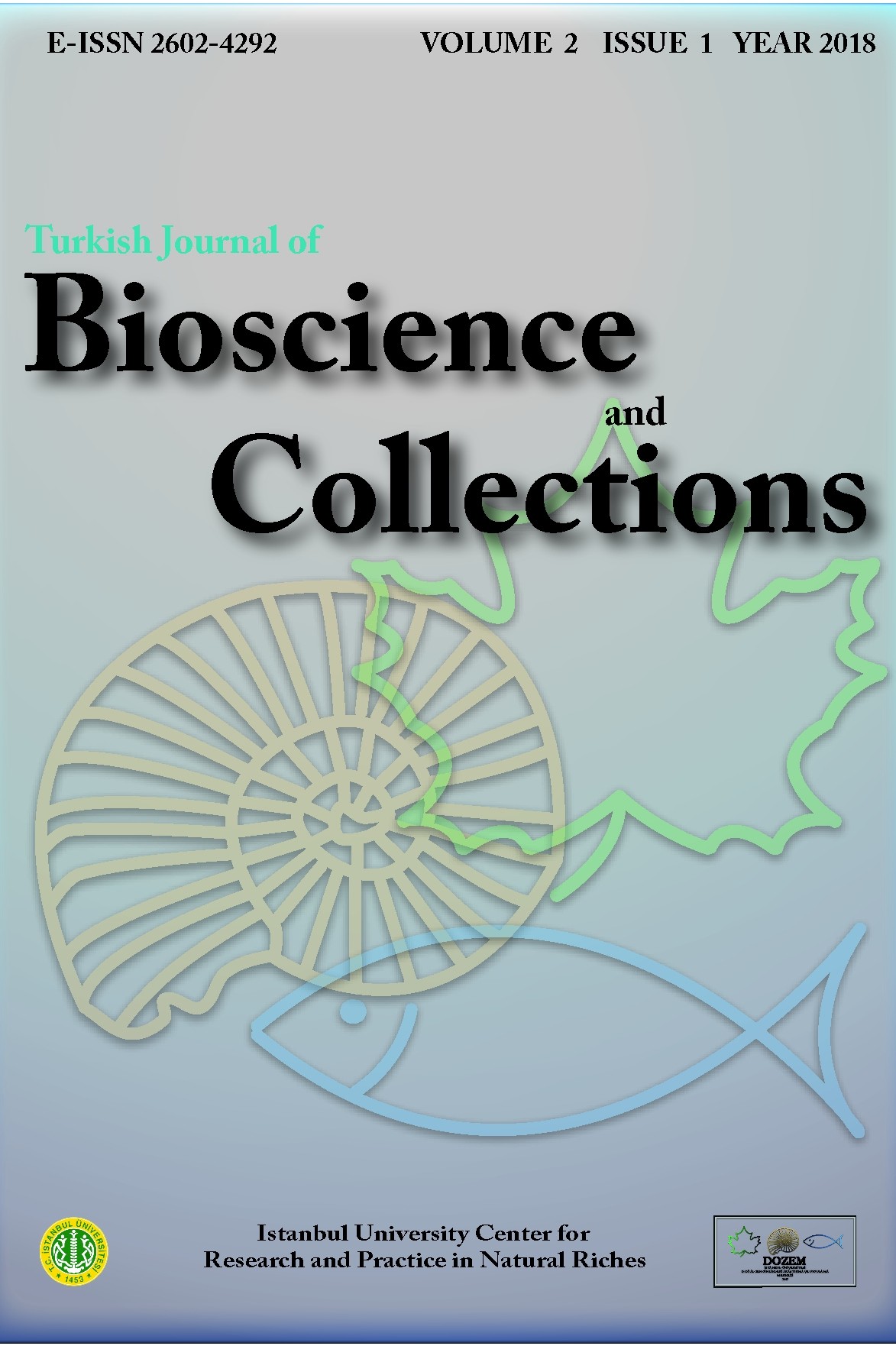The Important Taxonomic Characteristics of the Family Malvaceae and the Herbarium Specimens in ISTE
The Important Taxonomic Characteristics of the Family Malvaceae and the Herbarium Specimens in ISTE
Herbariums, which are places where dried plant specimens are regularly stored, have indispensable working material, especially for taxonomists. The Herbarium of the Faculty of Pharmacy of Istanbul University (ISTE) is one of Turkey’s most important herbariums and has more than 110 000 plant specimens some of which have medicinal properties. The species of the Malvaceae family that make up some of the plant specimens in ISTE are significant because they are widely used in traditional folk medicine. This family is represented by 10 genera and 47 species (3 endemic) in Turkey. In this study, the specimens of Malvaceae were examined and numerical evaluation of the family in Flora and in ISTE was given. Specimens of one species from every genus that are existing in ISTE were photographed and important taxonomic characteristics of family were shown. In conclusion, 39 taxa belonging to 9 genera in ISTE have been observed and 418 specimens from these taxa were counted. The genus Alcea, which has 130 specimens, has been found to have more specimens than all genera of Malvaceae family. Also, the diagnostic key to genera has been rearranged for the new genus added to the family.
Keywords:
Malvaceae, Herbarium Taxonomy, Medicinal Plants,
___
- Ali, M.E.E., Elkamali, H.H. & Eltahir, A.S. (2017). Comparative morph-anatomical studies on selected Sudanese medicinal plants: part ıv. Abutilon figarianum and Abutilon pannosum leaves. International Journal of Scientific World, 5(2), 168-171.
- APG III. (2009). An update of the Angiosperm Phylogeny Group classification for the orders and families of flowering plants: APG III. Botanical Journal of the Linnean Society, 161, 105-121.
- APG IV. (2016). An update of the Angiosperm Phylogeny Group classification for the orders and families of flowering plants: APG IV. Botanical Journal of the Linnean Society, 181(1), 1-20.
- Bacchetta, G., Garcíab, P.E., Grillo, O., Masciaa, F. & Venorac, G. (2011). Seed image analysis provides evidence of taxonomical differentiation within the Lavatera triloba aggregate (Malvaceae). Flora, 206, 468-472.
- Baytop, A. (1984). İstanbul Üniversitesi Eczacılık Fakültesi Herbaryumundaki Türkiye Bitkileri-1 Pteridophyta, Gymnospermae, Dicotyledones (Turkish Material Present in the Herbarium of the Faculty of Pharmacy of İstanbul University-I: Pteridophyta, Gymnospermae, Dicotyledones). İstanbul: TBTAK.
- Baytop, T. (1999). Türkiye’de Bitkilerle Tedavi. İstanbul: Sanal Matbaası.
- Celka, Z., Szkudlarz, P. & Biereznoj, U. (2006). Morphological variation of hairs in Malva alcea L. (Malvaceae). Biodiversity: Research and Conservation, 3(4), 258-261.
- Christensen, P.B. (1986). Pollen morphological studies in the Malvaceae. Grana, 25, 95-117.
- Da Silva, A.C.O., De Oliveira, A.F.M., Dos Santos, D.Y.A.C. & Da Silva, S.I. (2010). An approach to chemotaxonomy to the fatty acid content of some Malvaceae species. Biochemical Systematics and Ecology, 38, 1035-1038.
- Davis, P.H. (1967). Malvaceae. In P.H. Davis (ed.) Flora of Turkey and the East Aegean Islands (pp. 401-421). Vol. 2. Edinburgh: Edinburgh Univ Press.
- El Naggar, S.M. (2004). Pollen morphology of Egyptian Malvaceae: An assessment of taxonomic value. Turkish Journal of Botany, 28, 227-240.
- Esteves, G.L. (2000). Taxonomic characters of the staminal tube and epicalyx in Brazilian Pavonia (Malvaceae). Brittonia, 52(3), 256-264.
- Güner, A. (2012). Malvaceae. In A. Güner, S. Aslan, T. Ekim., M. Vural & M.T. Babaç (Eds.), Türkiye Bitkileri Listesi (Damarlı Bitkiler) (pp. 617-621). İstanbul: Nezahat Gökyiğit Botanik Bahçesi ve Flora Araştırmaları Derneği Yayını.
- Heywood, V.H. (1978). Flowering Plants of the World. London: Oxford University Press. ISBN 9780192176745
- Hutchinson, J. (1973). The Families of Flowering Plants (Angiospermae) Dicotyledones. Oxford: Oxford University Press.
- Kara, A., Algur, Ö.F., Köseoğlu, M.Ş. (2015). Bazı şifalı bitkilerin helicobacter pylori üzerindeki antimikrobiyal aktiviteleri. Cumhuriyet Science Journal, 32(2), 130-140.
- Kültür, Ş., Altınbaşak, O., Anıl, S., Melikoğlu, G. (2018). Türkiye’de mide ülserinde kullanılan tıbbi bitkiler. Marmara Pharmaceutical Journal, 22(1), 1-14.
- Nandıkar, M.D., Ravıkumar, K. (2017). Neotypification and taxonomic reinstatement of Grewia macrophylla G. Don (Malvaceae-Grewioideae). Taiwania, 62(3), 299-304.
- Ray, M.F. (1995). Systematics of Lavatera and Malva (Malvaceae, Malveae) - a new perspective. Plant Systematics and Evolution, 198, 29-53.
- Rouhi, H. & Ganji, F. (2007). Effect of Althaea officinalis on cough associated with ace inhibitors. Pakistan Journal of Nutrition, 6(3), 256-258.
- Saad, S.I. (1960). The sporoderm stratification in the Malvaceae. Pollen et Spores 2: 11-40.
- Shaheen, N., Khan, M.A., Hayat, M.Q. & Yasmin, G. (2009a). Pollen morphology of 14 species of Abutilon and Hibiscus of the family Malvaceae (sensu stricto). Journal of Medicinal Plants Research, 3(11), 921-929.
- Shaheen, N., Khan, M.A., Yasmin, G., Hayat, M.Q., Ahmad, M., Zafar, M. & Jabeen, A. (2009b). Implication of foliar epidermal features in the taxonomy of Abutilon Mill. (Malvaceae). Journal of Medicinal Plants Research, 3(12), 1002-1008.
- Taia, K.W. (2009). General view of Malvaceae juss. s.l. and taxonomic revision of genus Abutilon Mill. in Saudi Arabia. Journal of King Saud University, 21(2), 349-363.
- Tanker, N., Koyuncu, M., Coşkun, M. (2014). Farmasötik Botanik. 4th ed. Ankara: Başak Matbaacılık. ISBN 978-605-136-138-3
- Türkan, Ş., Malyer, H., Özaydın, S., Tümen, G. (2006). Ordu ili ve çevresinde yetişen bazı bitkilerin etnobotanik özellikleri. Süleyman Demirel Üniversitesi Fen Bilimleri Enstitüsü Dergisi, 10(2), 162-166.
- Yayın Aralığı: Yılda 2 Sayı
- Başlangıç: 2017
- Yayıncı: İstanbul Üniversitesi
